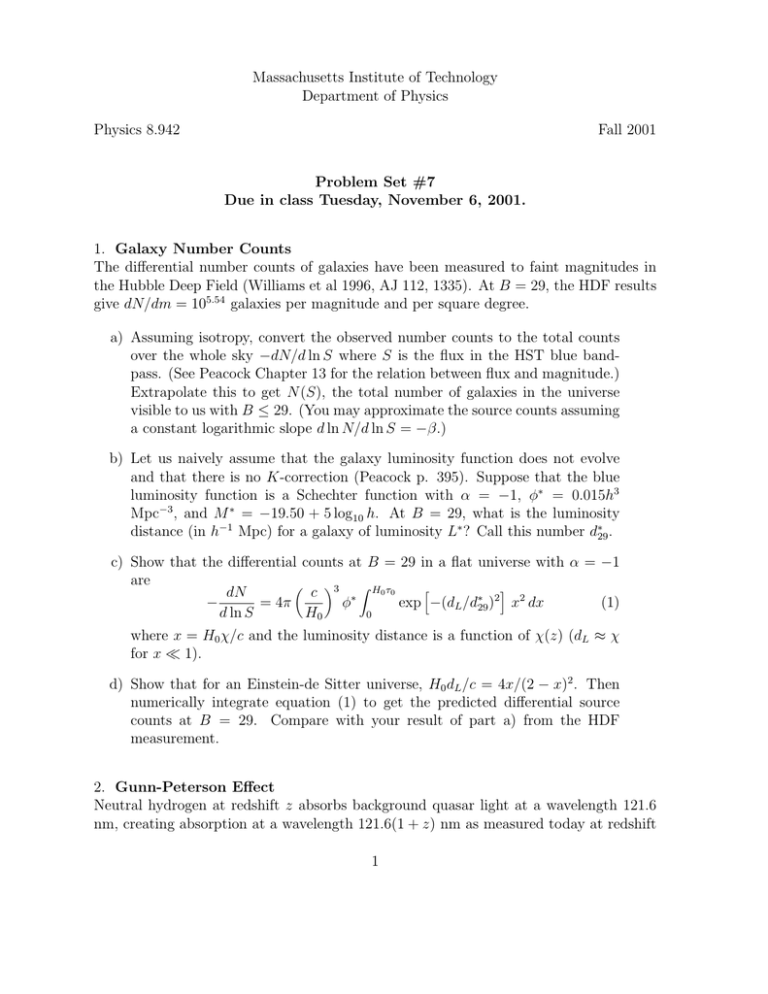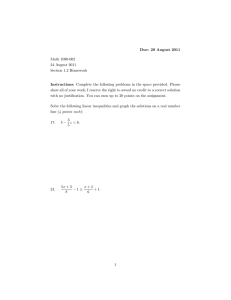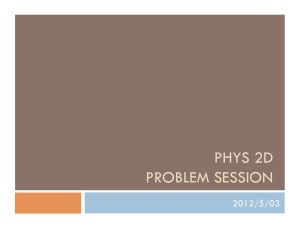Document 13650305
advertisement

Massachusetts Institute of Technology Department of Physics Physics 8.942 Fall 2001 Problem Set #7 Due in class Tuesday, November 6, 2001. 1. Galaxy Number Counts The differential number counts of galaxies have been measured to faint magnitudes in the Hubble Deep Field (Williams et al 1996, AJ 112, 1335). At B = 29, the HDF results give dN/dm = 105.54 galaxies per magnitude and per square degree. a) Assuming isotropy, convert the observed number counts to the total counts over the whole sky −dN/d ln S where S is the flux in the HST blue band­ pass. (See Peacock Chapter 13 for the relation between flux and magnitude.) Extrapolate this to get N (S), the total number of galaxies in the universe visible to us with B ≤ 29. (You may approximate the source counts assuming a constant logarithmic slope d ln N/d ln S = −β.) b) Let us naively assume that the galaxy luminosity function does not evolve and that there is no K­correction (Peacock p. 395). Suppose that the blue luminosity function is a Schechter function with α = −1, φ∗ = 0.015h3 Mpc−3 , and M ∗ = −19.50 + 5 log10 h. At B = 29, what is the luminosity distance (in h−1 Mpc) for a galaxy of luminosity L∗ ? Call this number d∗ 29 . c) Show that the differential counts at B = 29 in a flat universe with α = −1 are � � � � dN c 3 ∗ � H0 τ0 φ exp −(dL /d∗29 )2 x2 dx − = 4π (1) d ln S H0 0 where x = H0 χ/c and the luminosity distance is a function of χ(z) (dL ≈ χ for x � 1). d) Show that for an Einstein­de Sitter universe, H0 dL /c = 4x/(2 − x)2 . Then numerically integrate equation (1) to get the predicted differential source counts at B = 29. Compare with your result of part a) from the HDF measurement. 2. Gunn­Peterson Effect Neutral hydrogen at redshift z absorbs background quasar light at a wavelength 121.6 nm, creating absorption at a wavelength 121.6(1 + z) nm as measured today at redshift 1 zero. Treating the Lyman alpha line as being infinitely narrow, the absorption cross section per neutral hydrogen atom is σ(ν) = σα δ(ν − να ) , σα = πe2 fα me c (2) where ν = c/λ is frequency, να = c/(121.6 nm) is the Lyman alpha frequency, fα = 0.416 is the oscillator strength, and cgs units are used in writing σα (cf. Peacock eq. 12.36). In this problem we neglect peculiar velocities. The original reference by Gunn & Peterson (1965, ApJ, 142 1633) is a very readable guide to this problem (though beware it has some typos). a) Derive the absorption optical depth at observed frequency ν0 due to neutral hydrogen at 1 + z = να /ν0 . Your result should depend on σα , c, να , nHI , and H (the Hubble parameter at z). Compare your result with Peacock eq. (12.41) for a Friedmann universe. b) The measured optical depth versus frequency is not uniform but varies (the Lyman alpha forest) with nHI along the line of sight. The mean optical depth is unity at z ≈ 3. Assuming ΩB h2 = 0.019, h = 0.65, Y = 0.24 (with helium neutral), and the flat ΛCDM model with ΩΛ = 0.65, what is the mean neutral fraction 1 − xe of hydrogen atoms at z = 3? Compare with Peacock p. 364. c) In equilibrium, hydrogen atoms are photoionized and recombine at equal rates, implying (2) nHI β = ne np α (T ) or 1 − xe nH α(2) (T ) = x2e β (3) where nH = (1 − Y )ρB /mH and β= � ∞ νL dν ≈ 3 × 10−12 J−21 s−1 ; hν � � hνL , φ2 (T ) = 0.448 ln 1 + . (4) kT 4πJν σi (ν) α(2) = 2.06 × 10−11 T −1/2 φ2 (T ) cm3 s−1 Here, hνL = 13.6 eV is the ionization energy of hydrogen, σi is the ionization cross­section, T is the temperature in Kelvin, and J−21 is the mean intensity at frequencies just above νL (in units of 10−21 erg cm−2 s−1 Hz−1 ster−1 ). The α(2) excludes recombinations directly to the ground state (Case B recombi­ nation). For the ΛCDM model, assuming the gas temperature is 104 K, what J−21 is needed to ionize the gas to the level determined in part b)? 2


